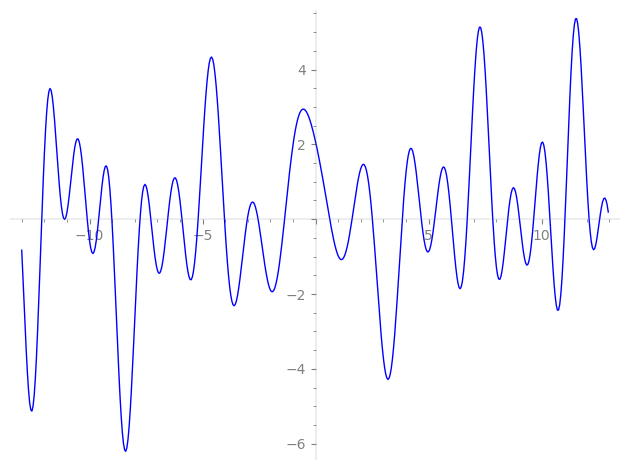| L(s) = 1 | + (2 + 3.46i)5-s + (1 − 1.73i)17-s + (−1 − 1.73i)19-s + (4 + 6.92i)23-s + (−5.49 + 9.52i)25-s − 2·29-s + (2 − 3.46i)31-s + (3 + 5.19i)37-s − 2·41-s + 8·43-s + (2 + 3.46i)47-s + (−5 + 8.66i)53-s + (−3 + 5.19i)59-s + (2 + 3.46i)61-s + (6 − 10.3i)67-s + ⋯ |
| L(s) = 1 | + (0.894 + 1.54i)5-s + (0.242 − 0.420i)17-s + (−0.229 − 0.397i)19-s + (0.834 + 1.44i)23-s + (−1.09 + 1.90i)25-s − 0.371·29-s + (0.359 − 0.622i)31-s + (0.493 + 0.854i)37-s − 0.312·41-s + 1.21·43-s + (0.291 + 0.505i)47-s + (−0.686 + 1.18i)53-s + (−0.390 + 0.676i)59-s + (0.256 + 0.443i)61-s + (0.733 − 1.26i)67-s + ⋯ |
\[\begin{aligned}\Lambda(s)=\mathstrut & 3528 ^{s/2} \, \Gamma_{\C}(s) \, L(s)\cr =\mathstrut & (-0.266 - 0.963i)\, \overline{\Lambda}(2-s) \end{aligned}\]
\[\begin{aligned}\Lambda(s)=\mathstrut & 3528 ^{s/2} \, \Gamma_{\C}(s+1/2) \, L(s)\cr =\mathstrut & (-0.266 - 0.963i)\, \overline{\Lambda}(1-s) \end{aligned}\]
Particular Values
| \(L(1)\) |
\(\approx\) |
\(2.068747313\) |
| \(L(\frac12)\) |
\(\approx\) |
\(2.068747313\) |
| \(L(\frac{3}{2})\) |
|
not available |
| \(L(1)\) |
|
not available |
\(L(s) = \displaystyle \prod_{p} F_p(p^{-s})^{-1} \)
| $p$ | $F_p(T)$ |
|---|
| bad | 2 | \( 1 \) |
| 3 | \( 1 \) |
| 7 | \( 1 \) |
| good | 5 | \( 1 + (-2 - 3.46i)T + (-2.5 + 4.33i)T^{2} \) |
| 11 | \( 1 + (-5.5 - 9.52i)T^{2} \) |
| 13 | \( 1 + 13T^{2} \) |
| 17 | \( 1 + (-1 + 1.73i)T + (-8.5 - 14.7i)T^{2} \) |
| 19 | \( 1 + (1 + 1.73i)T + (-9.5 + 16.4i)T^{2} \) |
| 23 | \( 1 + (-4 - 6.92i)T + (-11.5 + 19.9i)T^{2} \) |
| 29 | \( 1 + 2T + 29T^{2} \) |
| 31 | \( 1 + (-2 + 3.46i)T + (-15.5 - 26.8i)T^{2} \) |
| 37 | \( 1 + (-3 - 5.19i)T + (-18.5 + 32.0i)T^{2} \) |
| 41 | \( 1 + 2T + 41T^{2} \) |
| 43 | \( 1 - 8T + 43T^{2} \) |
| 47 | \( 1 + (-2 - 3.46i)T + (-23.5 + 40.7i)T^{2} \) |
| 53 | \( 1 + (5 - 8.66i)T + (-26.5 - 45.8i)T^{2} \) |
| 59 | \( 1 + (3 - 5.19i)T + (-29.5 - 51.0i)T^{2} \) |
| 61 | \( 1 + (-2 - 3.46i)T + (-30.5 + 52.8i)T^{2} \) |
| 67 | \( 1 + (-6 + 10.3i)T + (-33.5 - 58.0i)T^{2} \) |
| 71 | \( 1 + 71T^{2} \) |
| 73 | \( 1 + (7 - 12.1i)T + (-36.5 - 63.2i)T^{2} \) |
| 79 | \( 1 + (-4 - 6.92i)T + (-39.5 + 68.4i)T^{2} \) |
| 83 | \( 1 - 6T + 83T^{2} \) |
| 89 | \( 1 + (5 + 8.66i)T + (-44.5 + 77.0i)T^{2} \) |
| 97 | \( 1 - 2T + 97T^{2} \) |
| show more | |
| show less | |
\(L(s) = \displaystyle\prod_p \ \prod_{j=1}^{2} (1 - \alpha_{j,p}\, p^{-s})^{-1}\)
Imaginary part of the first few zeros on the critical line
−9.012219259332910874284935748867, −7.76679233843006839944444490973, −7.28804832595512287606106755915, −6.54286695062179918684502916235, −5.90947733141517000487513106681, −5.19524970094630884240125436941, −4.02964585873340844900127459211, −3.01999728223420432273379016585, −2.54388318054083608658843498475, −1.37169318387744329784635189955,
0.62749144485969038779114916663, 1.61354691657286283331511628625, 2.51413452533614293111305555332, 3.83627330332277467534591024871, 4.67870516459190559112360688322, 5.27013653752225416676142749432, 6.00979091530238650665108300516, 6.71030760177273511551002275405, 7.84031861569573747402608165382, 8.499494549783640319680022725911

